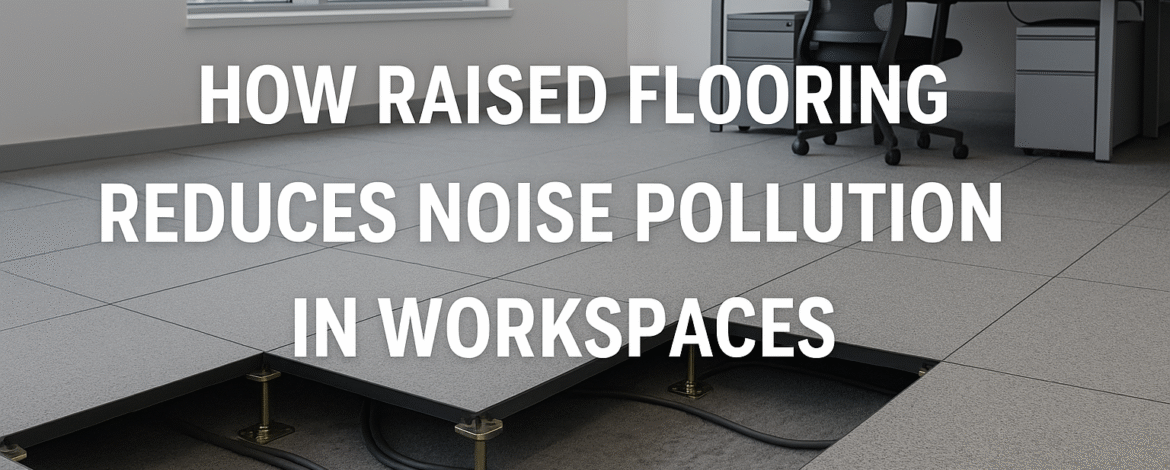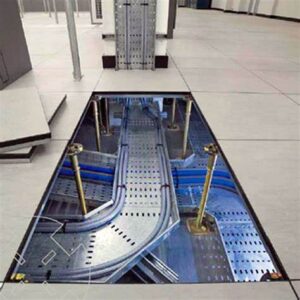How Raised Flooring Reduces Noise Pollution in Workspaces
Raised Flooring for Noise Control. Noise pollution in work environments is more than just a nuisance—it impacts productivity, focus, and employee well-being. The solution? Raised flooring systems. Learn how raised flooring reduces noise pollution in workspaces by minimizing sound transmission and absorbing disruptive noises. Ideal for modern offices, server rooms, and collaborative environments, raised flooring creates a quiet and professional atmosphere. Engineered with sound-dampening features and customizable underfloor systems, it provides a seamless blend of function and comfort. Discover how incorporating raised access flooring can transform your workspace into a serene, acoustically-optimized zone.
Soundproofing Innovation: How Raised Flooring Reduces Noise Pollution in Workspaces
Raised Flooring for Noise Control. In today’s fast-paced corporate world, a quiet work environment is not a luxury—it’s a necessity. Constant noise from electronics, foot traffic, HVAC systems, and collaborative discussions can create a chaotic atmosphere, leading to lower concentration levels and higher stress. Thankfully, one solution is proving to be both innovative and effective: raised flooring systems.
What Is Raised Flooring?
Raised flooring is a type of flooring system consisting of modular panels supported by adjustable pedestals, creating an accessible space between the subfloor and the actual floor surface. This plenum space is typically used for housing cables, HVAC ducts, and now—soundproofing materials.
But the benefits go far beyond cable management. Let’s dive into how raised flooring reduces noise pollution in workspaces and why it’s becoming a staple in smart office designs.
Acoustic Benefits of Raised Flooring
-
Noise Absorption
Raised floors are often manufactured using sound-absorbing materials like high-density calcium sulphate or mineral-filled polypropylene. These panels absorb airborne noise and impact sounds—reducing the echo and reverberation typically found in open offices. Raised Flooring for Noise Control -
Sound Isolation
The air gap between the raised floor and subfloor acts as a sound buffer. Vibrations and footsteps are absorbed or redirected rather than being transmitted directly into the structure. This reduces the “thud” or “clunk” noises from foot traffic.Raised Flooring for Noise Control -
Customizable Soundproofing
You can insert acoustic pads, insulation materials, or anti-vibration mats in the plenum space. These customizable options let facility managers tailor the acoustic environment depending on the workspace’s purpose—whether it’s a quiet meeting room or a bustling open-plan area. -
Reduced Equipment Noise
Offices that rely on servers, printers, and other machines benefit from raised flooring. Equipment can be placed over or inside access floor systems, and noise generated by them can be dampened with specialized enclosures and underfloor sound barriers. Raised Flooring for Noise Control -
Improved Speech Privacy
By minimizing sound travel between workstations, raised floors improve speech privacy. This is crucial in areas like HR departments, conference rooms, and executive offices.
Real-World Impact on Workspaces
Installing raised flooring in your office or commercial building can significantly improve the acoustic environment. Studies show that a quieter workspace boosts focus, enhances employee satisfaction, and even reduces absenteeism.
Modern workspaces that use raised floors often report:
-
Up to 30% reduction in perceived ambient noise levels.
-
Enhanced productivity in collaborative and individual work zones.
-
A more professional, premium office aesthetic.
Applications Across Industries
-
Corporate Offices – for reduced chatter and focused productivity
-
IT/Data Centers – to dampen equipment noise
-
Healthcare Facilities – for quieter patient environments
-
Educational Institutions – to support effective learning and teaching
-
Broadcast & Media Studios – for optimal acoustic control
Specifications: How Raised Flooring Reduces Noise Pollution in Workspaces
| Feature | Specification |
|---|---|
| Panel Type | Anti-vibration, acoustic-rated panels |
| Core Material | High-density calcium sulphate |
| Surface Finish | High-pressure laminate or carpet tiles |
| Understructure Height | 150mm to 600mm (adjustable) |
| Sound Absorption Coefficient | NRC 0.65–0.90 |
| Acoustic Padding | Optional underpanel foam or rubber layers |
| Load Capacity | 1250–2000 lbs per panel |
| Plenum Insulation | Available with mineral wool or acoustic foam |
| Fire Resistance | Class A or EN 13501-1 |
| Moisture Resistance | Yes, up to 95% RH |
| Thermal Insulation | Integrated (optional) |
| Cable Management | Built-in channels for noise-free routing |
| Panel Size | Standard 600mm x 600mm |
| Anti-static Properties | Available for server environments |
| Life Expectancy | 25+ years with maintenance |
FAQs
1. How does raised flooring help with noise control?
Raised flooring absorbs impact and airborne noise through its structure and materials, significantly lowering noise pollution in offices.
2. Can I install raised flooring in an existing office?
Yes. Raised flooring systems are modular and can be retrofitted into most commercial spaces with minimal disruption.
3. Is it possible to add more soundproofing after installation?
Absolutely. You can upgrade the plenum space with sound-absorbing materials like foam or rubber without removing the entire system.
4. Will raised flooring interfere with HVAC or data systems?
Not at all. Raised flooring improves HVAC efficiency and keeps cabling organized and protected, reducing both noise and clutter.
5. How long does installation take?
Depending on the area size, most raised flooring systems can be installed within a few days to a week.
Why Choose “How Raised Flooring Reduces Noise Pollution in Workspaces”
Choosing raised flooring for your workspace is an investment in your team’s productivity, comfort, and focus. With cutting-edge acoustic engineering, it doesn’t just look sleek—it performs. Whether you’re designing an office from scratch or upgrading an existing space, this flooring system blends form, function, and future-readiness. Quiet offices aren’t a dream anymore—they’re a design choice.
Pros and Cons Table
| Pros | Cons |
|---|---|
| Excellent noise reduction | Initial installation cost can be high |
| Customizable soundproofing | Requires professional installation |
| Easy access for cabling and HVAC | Slightly elevates floor height |
| Enhances workspace aesthetics | Not suitable for all flooring types |
| Increases privacy in open-plan offices | May require structural evaluation before installation |
|
|
|
|



